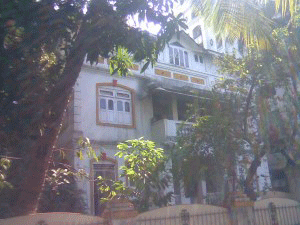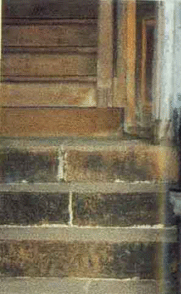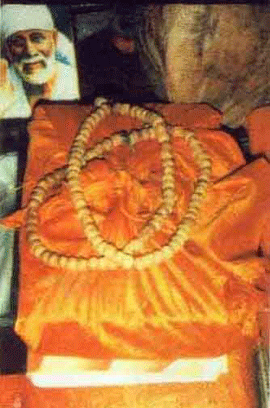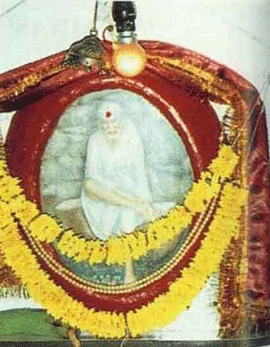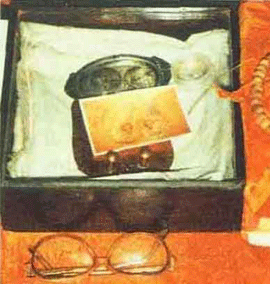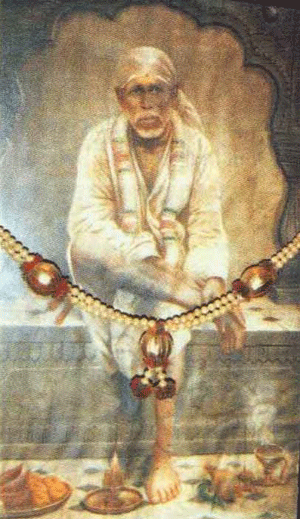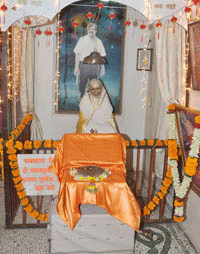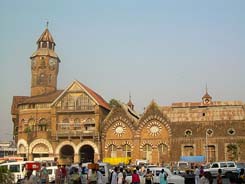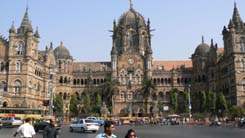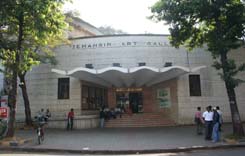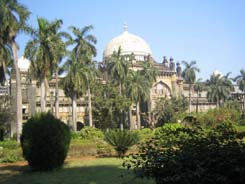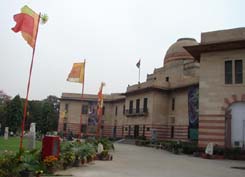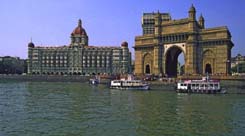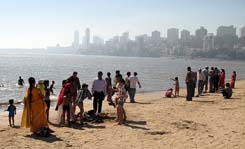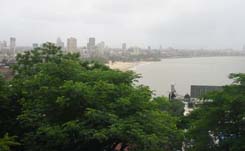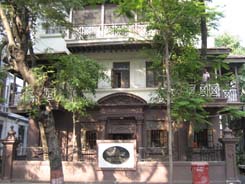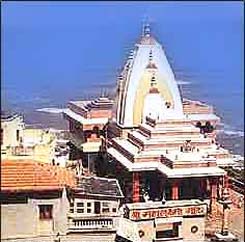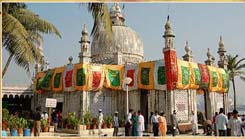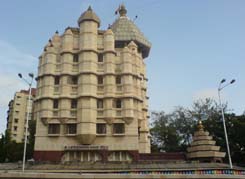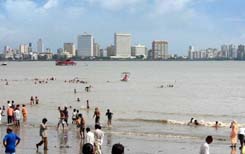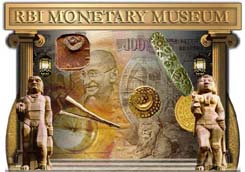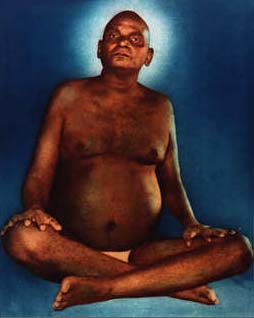Places Around Mumbai
HOUSE OF DHABOLKAR ALIAS HEMADPANT “SAI NIWAS” Hemadpant’s Simga Dinner (Full Moon Day – Holi Festival Day) (Refer Sai Satcharitra Chapter 40) was performed in this very house. This house is well maintained and kept “as is” with all the memorablia.
The ancestral home of the Dabholkar's in Bandra STAIRCASE The members of the family were about to start eating, when the footsteps were heard on these Stairs. Dhabolkar went immediately and opened the door and saw Ali Mohammed and Moulana Isnu Mujawar with a packet.
Staircase THE POTHI Dhabolkar started writing the “Sai Satcharitra” in the year 1910 which was published in the year 1929. This Pothi should be in every house, and should be lovingly and respectfully read. Baba will be pleased by removing ignorance and poverty, will give knowledge, wealth and prosperity. With a concentrated mind if one reads at least a Chapter daily, it will give unbounded happiness. This work should be read at home specifically on “Gurupurnima” and on other holy days. If you study this one book all your desires will be satisfied and Sai will easily make you cross this “Bhava Sagara”. The sick will get health, poor will get wealth and the mind will get steadiness (Refer Sai Satcharitra Phalastuti, Epilogue).
The Pothi THE DESK This is the desk on which Dhabolkar wrote the Sai Satcharitra. The place used to be in the corner of the prayer room just below the original photo of Saibaba. On this desk, he spent many loving hours writing about the Leelas of Baba and thus gave us Ambrosia. BABA’S MURTI This Murti is used for meditating on, and his “life like eyes” sees through and through you. Many leelas of this Murti are stated by Mrs.Dhabolkar. SIMGA DINNER PHOTO This beautiful plaster of paris statue was brought by Ali Mohammed and Moulana Isnu Mujawar and was set in the place that was reserved for Baba at the “Simga Dinner” (Refer Sai Satcharitra Chapter 40). Baba kept his promise to attend the Dinner in the dream of Dhabolkar and arrived in this form.
Simga Dinner Photo SACRED ARTICLES In the Puja room they have enclosed various items with a wooden railing, at the left corner of his Pagdi. In a glass topped box two coins given by Baba, holy Padukas of Baba, spectacles of Hemadpant are kept.
Baba's Padukas and Coins given by Baba to Dabolkar BABA’S PORTRAIT This beautiful portrait of Baba was painted by Shyamrao Jaykar. “Baba sitting on Stone” posture is on the left wall just upon entering the house. It is a masterpiece, luminous, pensive and most of all forgiving. It was painted on 26th December 1916. It is dated and signed. Many wondrous things are happening to this photo. Painted some 80 years ago one can see a “Shesha Nag” behind Baba, but most interestingly a “Swastik” on Baba’s chest. It looks like as if someone made a “Chandan Swastik”. There is another “Swastik” on Baba’s right foot.
In the year 1997, Sadguru Shri Aniruddha Bapu established the statue of Sainath in Sai Niwas for the purpose of meditation. From that day onwards devotees are allowed to sit or meditate in front of this divine statue and chant the mantra “Om Krupasindhu Shri Sainathaya Namaha”.
On 28th March 1996, Shri Appasaheb Dabholkar and Meenavahini Dabholkar, Grandson and Granddaughter-in-law of Shree Hemadpant had the darshan (vision) of Sainath Himself in place of Sadguru Aniruddha Bapu. Shree Sai Niwas has since then been transformed into Dwarkamai to protect its devotees. Darshan Timings: The Darshan Timings are between 8.00am to 1.00pm and 4.30pm to 10.00pm on all days except Thursday’s when the Darshan Timings is from 8.00am to 4.30pm. Aarti Timings:
Festivals Celebrated at Sai Niwas:
Location and Direction: Location: Sai Niwas is located very close to Bandra Railway station at approximately 10 minutes walking distance from the Railway Station). Address: Head Office: Shree Aniruddha Upasana Foundation Contact Persons: Sri.Sunilsinh Mantri, / Sri. Maheshsinh Zantye – Chief Executive Officers Contact Numbers: +91 98690 22971 / +91 98210 75164 Email Address: mansunil@gmail.com / maheshzantye@yahoo.co.in Website: http://www.aniruddhafoundation.com/sai_niwas_tirthakshetra.html Direction: Sai Niwas is located very close to Bandra Railway station at approximately 10 minutes walking distance from the Railway Station).
(Source: Ambrosia in Shirdi by Vinny Chitluri & Aniruddha Foundation) |
|
Mahatma Jyotiba Market |
Mahatma Jyotiba Phule Market (Crawford Market) A busy market area, this is best visited early on in the day. The fruits and vegetable section offers the best of produce. Depending on when you visit, the fruit/s of the season is always a good buy.
|
Victoria Terminus |
Chhatrapati Shivaji Terminus (Victoria Terminus) This is a magnificent building, and considered to be architecturally one of the finest stations in the world. Built by the British in 1888, it has exquisite ornamentation on its facade along with beautifully executed panels and friezes. It holds the statue of Queen Victoria on its dome. |
Flora Fountain |
Flora Fountain and the Gothic/Victorian buildings of the Fort Area The Flora Fountain stands on the site of the old church gate of the Bombay Fort, now a major crossroad named Hutatma Chowk. It was erected to honour Sir Bartle Frere, a former governor of Bombay and named after the Greek goddess Flora. Other buildings to see in the Fountain or Fort area are the University of Mumbai buildings including the imposing Rajabhai Tower, the Mumbai High Court, the Old Secretariat, and the Institute of Science on one end. Close by are situated St Thomas Cathedral, the Asiatic Society of Bombay or Town Hall, the Office of the Director General of Police, the General Post Office and the Thomas Cook building. The Western Railway Headquarters is also quite near, across the street from the Churchgate Station. These buildings are fine examples of the Gothic and Indo-Saracenic style. Many are illuminated by night. An exotic way of seeing these sights would be by the MTDC open-air bus or by the few surviving Victorias or buggy rides. Close by to Flora Fountain is the Kala Ghoda area which holds a once a week fair (every Sunday) from November to January. |
Jehangir Art Gallery |
Jehangir Art Gallery Close by to the Prince of Wales Museum, this gallery is the showcase for contemporary art. The displays change regularly. Outside is the Artist's Plaza with more paintings on display and sale. Open daily from 11 am to 7 pm. |
Prince of Wales Museum |
Prince of Wales Museum This is one of Mumbai's finest example of Victorian architecture. Built to commemorate King George V's visit to Mumbai (while still Prince of Wales), it was designed by George Wittet and completed in 1923. It is
undoubtedly one of India's finest museums and houses treasures, artefacts, paintings and sculpture from the many periods covering India's history, including the Indus Valley Civilization. Open from Tuesday to Sunday, 10.30 am to 6 pm. |
NGMA |
National Gallery of Modern Art (NGMA) This is the former Cowasji Jehangir Hall, of the Institute of Science. It has been renovated to serve as a four-storey exhibition hall, displaying the best of Indian contemporary art. Open daily except Monday, from 10 am to 5 pm. |
Gateway of India |
Gateway of India Mumbai's most striking monument, this too was designed by George Wittet. It has an imposing gateway arch in the Indo-Saracenic style with Gujarati and Islamic elements such as wooden carvings. It was built to commemorate the visit
of King George V and Queen Mary to India in 1911. This area is also the departing point for ferries plying to Elephanta Island and other beaches across the port. Behind it is the beautiful old (and new) structure of the Taj Mahal Hotel |
Marine Drive and Chowpatty Beach |
Marine Drive and Chowpatty Beach This is the stretch now known as Netaji Subhashchandra Bose Road with Nariman Point on one end to Babulnath, at the foot of Walkeshwar on the other. For the most part, a pleasant promenade continues along the beach
with the Chowpatty area situated somewhat in the middle. Chowpatty Beach is a teeming mass of people, vendors, masseurs and roadside restaurants with its specialties being bhelpuri and kulfi. Across the Chowpatty Beach area is the Taraporewala Aquarium. Marine Drive is also referred to as the Queen's Necklace because of the dramatic line of street lamps lit up at night. |
Malabar Hill |
Malabar Hill This is essentially an up-market residential area with some spectacular views of the city surroundings. On the road climbing up, is a Jain temple dedicated to Adinath, the first Jain tirthankara. At one end, on the top are the Hanging Gardens (Pherozeshah Mehta Gardens) and the Kamala Nehru Park. Both provide relaxing atmospheres of greenery. Beside the Hanging Gardens are the Parsi Towers of Silence. But these are off-limits to all except those who have come to dispose and pay respect to the dead. Towards the other end is the Banganga temple complex at Walkeshwar, considered to be one of Mumbai's holiest sites. Local legend has it that the Hindu god Rama rested here on his way to rescue Sita (his wife) from Lanka. The Banganga Tank is supposedly the spot where Rama shot his bow or bana. Further away is the British built Raj Bhavan, the residence of the governor of Maharashtra. The Banganga Festival of Music is a yearly highlight, and is in the month of January usually. |
Mani Bhavan |
This simple and charming museum was where Mahatma Gandhi lived on his visits to Mumbai between 1917 and 1934. Gandhi's room and belongings including his books are on display. Mani Bhavan is situated on Laburnam Road,
near the August Kranti Maidan, where the 'Quit India' movement was launched in 1942. Open daily from 9.30 am to 6 pm |
Mahalaxmi Temple |
Mahalaxmi Temple The Mahalaxmi Temple is a popular holy site as Mahalaxmi is the goddess of wealth. It is situated at one end of Breach Candy -- a trendy residential and shopping area, now known as B. Desai Road. |
Haji Ali Shrine |
Haji Ali Shrine Further along the seashore, at the end of a long pathway surrounded by seawater is the shrine dedicated to Haji Ali, a Muslim saint. Access is only at low tide via the pathway. |
Siddhivinayak Temple |
Siddhivinayak Temple Located in the Prabha Devi area of Mumbai, this popular temple dedicated to Ganesh was rebuilt on the site of a 200-year old temple. Built of black stone, the idol of Ganesh is two and a half feet in height and two feet in width. An unusual feature of the statue is that the trunk turns to the right, not often found on Ganesh idols. Tuesday is the main day of darshan and puja, but this temple is frequented by hundreds of devotees every day. More more information please visit: http://www.siddhivinayak.org |
Juhu Beach |
Juhu Beach This suburban beach is great favourite with Mumbaites, and has plenty to offer everyone. Like Marine Drive's Chowpatty, Juhu 'Chowpatty' is a vendor's delight with innumerable food counters. It is a wonderful place to bring kids, as it doubles up as an amusement park, play ground, and open-air restaurant. An unusual sight at this beach is the camel ride, which is both fun and popular. |
RBI Museums |
The Reserve Bank of India (RBI) is the central bank of the country. As the central bank, it is also the custodian of the country's monetary heritage. To document and preserve India's monetary history for the posterity and as a part of the Reserve Bank's education and outreach programme for the common man, especially the students, the Reserve Bank has conceived the Monetary Museum. |
Bhagwan Nityananda of Ganeshpuri Bhagawan Nityananda (November/December, 1897 – August 8, 1961) was an Indian guru. His teachings are published in the "Chidakash Gita". Nityananda was born in Quilandy (Pandalayini), Kerala, South India.
The Great Guru swami Nityanand sanctified Ganeshpuri. The Place is beautiful - so tranquil and serene. As soon as you enter the temple you feel the world slipping away and calm and serenity descending on you. The blessed peace of silence is tangible here. No voices are raised and people speak only when necessary. Ganeshpuri is a small township about seventy-five kilometers from Mumbai and eighteen kilometers from Bhivandi. It comes under Thane district, that lies in the northwest of Maharashtra state.
The modes of transport in Thane district are roads and railways. We find many roads and railway here as Thane district lies close to Mumbai City and Mumbai suburban districts. Contact Details: |
|
